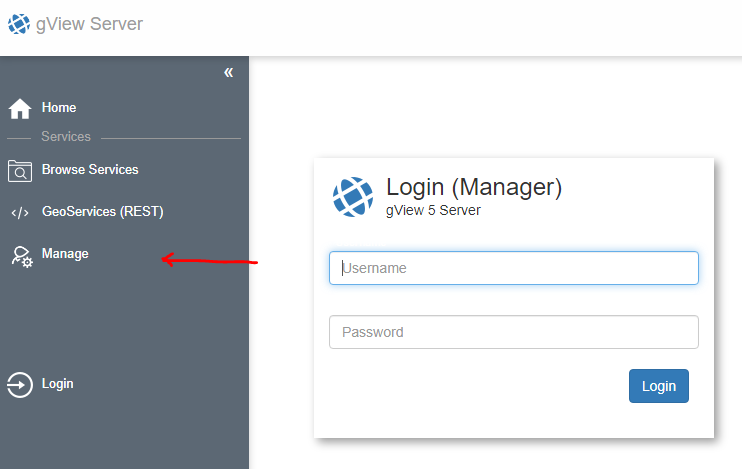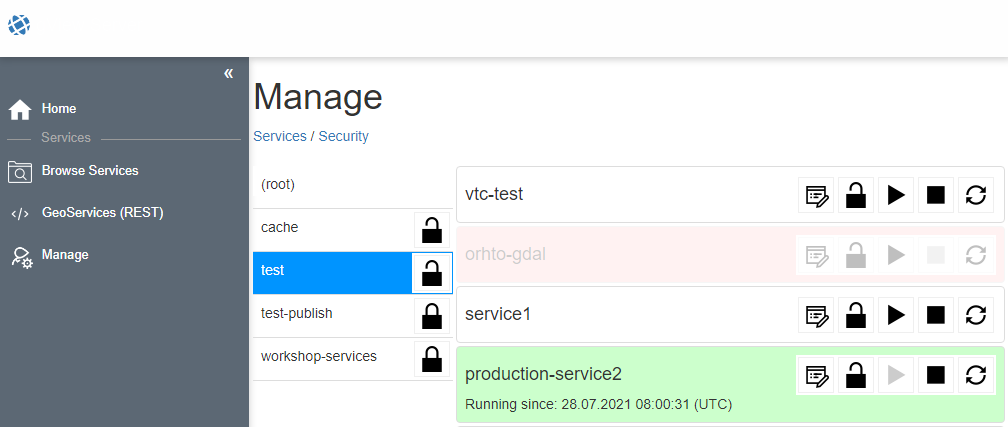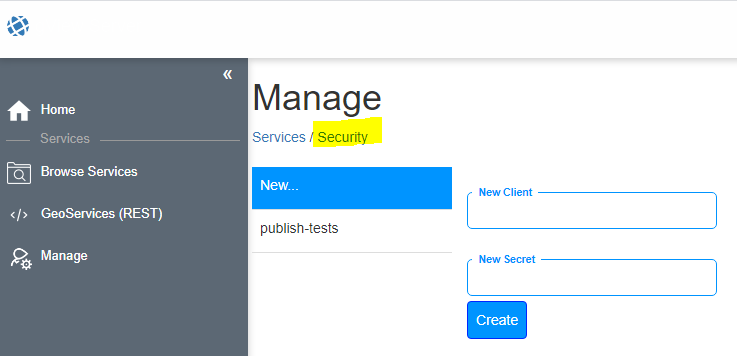Managing gView Server¶
An administrator account has already been set up under Post-installation for managing the gView MapServer.
With this user, you can:
create new directories
publish services via the web interface
stop and restart services
display service log files
create clients.
Logging in as Administrator¶
Login is done via the Manage link from the sidebar:

Manager Interface¶
Once logged in as an administrator, the manager interface appears approximately like this:

On the left, the directories (Folders) in which services are organized are displayed. Next to them, the services located in these directories are shown.
Creating Clients¶
Clients are known Web Applications that access the services on the gView MapServer. For instance, if a WebGIS application accesses services, a client can be created for it. Each client has a secret to log in to the gView MapServer when accessing it. Client and secret are similar to user and password, except that a client is typically not a physical person but an application.
Note
If you want to give only certain users access to specific services later, there must be a separate authorization layer in the respective Client software (WebGIS).
In the manager interface, you can switch between Services and Security at the top.
Under Security, new Clients can be created or existing Secrets modified:

Service Permissions¶
In general, services with similar characteristics (production/test, special permissions) should be organized within Folders. Permissions can then be set at the Folder level and apply to all services within the Folder. Alternatively, permissions must be set individually for each service.
Note
Permissions are organized hierarchically. If a right is not possible over the Folder, it is also not available for a service within this Folder. Additional permissions for a service within a group can only further restrict access.
Whether permissions have been set for a service or a Folder can be recognized by the lock icon. If the lock is open, no permissions have been set yet. All services are then available to every user.
For example, clicking on the lock icon for a Folder opens the following dialog:

Here, no permissions have been set yet, meaning every user/client can use all services in this Folder without restriction.
Note
An exception is the Publish Service right, which can only be assigned to a client. Only authorized clients and the administrator can publish services.
Export Map: Map images can be retrieved for any area.
Query: Geo-objects can be queried and searched.
Features: Geo-objects can be downloaded or edited as features. This requires the GeoServices REST interface. The geo-objects that can be edited are set in the map project (MXL) through gView Carto in the Ribbon under Options.
Publish Service: Services can be published and deleted for this directory.
Interfaces: Permissions can be restricted for specific interfaces (WMS, etc.).
In the selection list, an existing client can be chosen. A special case is the
client _anonymous, which is always automatically offered in the selection list.
This client is always used for authorization when no
login is performed by the client application. For this client, the following can be set:

This means that an anonymous client is allowed to fetch map images and query geo-objects for the services in this folder. However, only the
WMS and WMTS interfaces are available for the services.
In the next step, clients can be granted more specific rights:

As visible above, additional values for the folder can be entered in this dialog
(Online Resource (override) and Output Url (override)).
This can override the values from _config/mapserver.json. This can be useful when
a server is accessible from the internet via different URLs or when services of a
folder are published via a proxy. Typically, these values can be left empty.
Service Status¶
Services can have a specific status during runtime. This is visible in the Manage interface in the service list (see above):
Idle: The service appears “white” in the list. The service is available, but has not yet been started/called by a client.
Running: The service has been initialized and is running (green).
Stopped: The service has been stopped by the administrator. It is no longer visible to clients. In the Manage interface, the service is displayed transparently.
Additional colors:
Red: The service has caused errors since the last start.
Each service also has command buttons available that can influence the status, for example:

Logs: Display (Error) logs for this service
Security: Set permissions for this service
Start: Start the service (if stopped)
Stop: Stop the service (afterwards, it is no longer visible to clients)
Refresh: Forces a restart of the service